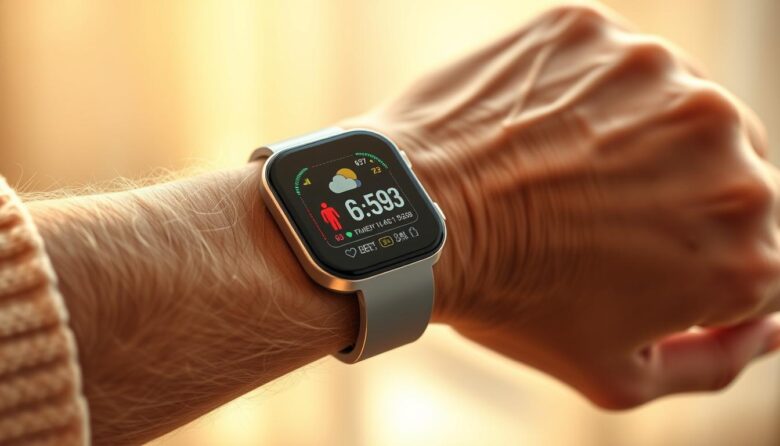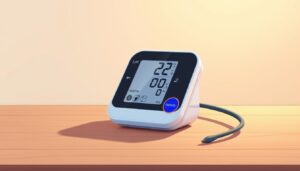Staying active and informed about your wellness has never been easier. Modern devices like fitness bands and smartwatches now do far more than count steps. They track heart rhythms, sleep patterns, and even recovery metrics—giving you a clear picture of your daily health trends.
For older adults, these tools offer more than convenience. Continuous monitoring can alert you to irregularities early, like sudden changes in heart rate or blood oxygen levels. Sharing this data with your doctor helps them spot potential issues before they escalate.
Options range from basic models under $100 to advanced wearables with medical-grade sensors. The Fitbit Charge 6, for example, combines cross-platform compatibility with a 7-day battery life. At $159.95, it’s a top choice for tracking workouts, stress levels, and overall activity.
These devices empower you to maintain independence while staying connected to your care team. Whether you’re managing a chronic condition or simply prioritizing fitness, real-time insights put you in control of aging gracefully.
Key Takeaways
- Modern devices now track heart health, sleep quality, and recovery metrics beyond basic step counting.
- Continuous monitoring helps detect potential health changes early, offering peace of mind.
- Affordable options start under $100, with premium models featuring hospital-grade sensors.
- Sharing data with healthcare providers supports proactive care and personalized advice.
- Long battery life and user-friendly designs make these tools ideal for active aging.
Understanding the Benefits of Health Trackers for Seniors
Today’s technology offers seniors a new way to stay proactive about their well-being. Devices continuously check your heart rhythm and oxygen levels, sending alerts if something seems off. This constant oversight brings peace of mind, knowing potential issues get flagged early.
Setting daily movement targets keeps you motivated to stay active. Celebrate hitting your step goal or completing a gentle workout—small wins that add up to better fitness over time. Consistent activity supports joint flexibility and balance, key factors in maintaining independence.
During medical visits, share your device’s reports to give doctors a clear picture of your patterns. They’ll notice trends in sleep quality or heart rate variability that single checkups might miss. This data helps tailor advice to your unique needs.
Never miss a pill again with gentle buzzes reminding you when it’s time for medication. Some models even nudge you to drink water throughout the day. These features help maintain routines that keep you feeling your best.
Spotting irregularities early can make all the difference. Your device might detect subtle changes in breathing during sleep or unusual heart rhythms, prompting timely checkups. Early intervention often leads to simpler treatments.
Family members can view your activity summaries through secure apps, letting them support your goals from afar. Whether it’s cheering you on or noticing reduced mobility, loved ones stay connected to your wellness journey.
Why Monitoring Health is Crucial for Older Adults
Maintaining your independence as you age starts with understanding your body’s signals. Regular monitoring helps catch subtle changes that affect daily life. Early detection of irregularities gives you time to address concerns before they escalate.
Continuous tracking reveals patterns in heart rhythms and sleep quality that single tests might miss. Spotting irregular beats early can prompt timely conversations with your doctor about cardiovascular risks. Similarly, poor sleep patterns linked to cognitive decline become clearer with nightly data.
Staying active supports bone density and muscle strength—critical for avoiding falls. Movement tracking helps ensure you meet goals tailored to your capabilities. Even gentle exercises contribute to maintaining fitness health over time.
Blood oxygen sensors alert you to breathing issues often overlooked until symptoms worsen. Pair this with stress-level insights, and you gain tools to manage both physical and mental aspects of fitness health. Together, these features create a safety net for thriving in your later years.
Features to Consider in Wearable Health Trackers
Choosing the right tools to monitor your wellness requires careful consideration of key features. Prioritize devices that balance precision with ease of use, ensuring they adapt to your daily routines while delivering meaningful insights.
Accurate Heart Rate and Sleep Tracking
Look for medical-grade sensors that capture heart rate data during walks, workouts, and rest. Devices like the Fitbit Charge 6 use continuous monitoring to detect irregularities, alerting you if readings fall outside your personalized thresholds.
Advanced sleep tracking should break down your nightly patterns into stages—light, deep, and REM. Garmin models analyze these phases alongside recovery metrics, helping you adjust habits for better rest quality. Consistent data reveals trends that single-night assessments might miss.
User Customization and App Integration
Opt for companion apps with adjustable settings like larger text sizes and simplified menus. These features make navigating your stats effortless. Share access with family through secure portals, letting loved ones support your goals without invading privacy.
Ensure seamless sync with platforms like Apple Health or Google Fit. This integration lets doctors review your tracking history during checkups, creating care plans based on real-world patterns. Some devices even send gentle nudges for hydration or medication times, reinforcing healthy habits.
Comparing Top Products in the Health Tracker Roundup
Finding the right device to monitor your wellness doesn’t have to feel overwhelming. Let’s break down six standout fitness trackers that balance functionality with senior-friendly designs.
The Fitbit Charge 6 ($159.95) shines as a versatile pick with 40 exercise modes and Google app integration. Sync it with Maps or Wallet for seamless daily use. If you’re an iPhone user, the Apple Watch Series 10 ($411.91) delivers unmatched fall detection and emergency SOS alerts—critical features for peace of mind.
Android lovers will appreciate the Samsung Galaxy Watch 8 ($349.99). Its AI coaching and precise heart rate tracking adapt to your activity levels. For those new to tech, the Fitbit Inspire 3 ($79.95) offers week-long battery life and essential metrics at a budget-friendly price.
Style-conscious users might prefer the Garmin Lily 2 ($243.99). This sleek option combines fashion with detailed sleep and stress analysis. Meanwhile, the Oura Ring 4 ($349) operates invisibly—no screen needed—while monitoring vital signs during walks or rest.
Each product serves different priorities. Consider your smartphone compatibility, preferred features, and budget when choosing. Reviews show most seniors value simplicity and reliability over flashy extras—focus on what keeps you consistent.
Innovative Technologies for Senior Health Monitoring
Modern sensor technology offers unprecedented insights into daily well-being for aging individuals. Devices now detect subtle changes in your body that might otherwise go unnoticed, giving you actionable data to share with care providers.
Advanced ECG features in products like the Apple Watch Series 10 scan for irregular heart rhythms linked to atrial fibrillation. This early detection could prevent strokes—a critical advantage for older adults. Blood oxygen sensors meanwhile track respiratory patterns, alerting you to potential issues during sleep or daily activities.
Safety features take center stage with automatic fall detection. If you take a hard tumble, the device contacts emergency services and shares your GPS location. Family members can also receive alerts, adding peace of mind for those living independently.
Skin temperature sensors spot fevers or infections before symptoms become obvious. Pair this with sleep apnea detection, and you gain tools to address common but underdiagnosed senior health concerns. Voice commands let you operate devices hands-free—ideal if arthritis affects dexterity.
These monitoring advancements create a safety net that adapts to your lifestyle. By combining medical-grade sensors with intuitive designs, modern gadgets help seniors maintain autonomy while staying connected to support networks.
Evaluating Battery Life and Charging Efficiency
Your device’s staying power matters when managing daily wellness routines. Extended battery life reduces how often you need to plug in, keeping your data flowing without interruption. Let’s explore what keeps these tools running smoothly.
Long-Lasting Performance
Aim for gadgets offering 5-7 days per charge. The Garmin Venu Sq 2 leads with 11 days—perfect for trips or busy weeks. Even basic models like the Samsung Galaxy Fit3 last a full week. Solar charging on select Garmins adds extra days, ideal for outdoor enthusiasts.
Consistent power ensures your stats stay accurate. Missing sleep data or heart rate trends due to a dead battery defeats the purpose. Devices with gradual degradation warnings help plan replacements before reliability drops.
Quick Charging Options
Top up your device during breakfast or a shower. Magnetic chargers snap on easily—no fumbling with tiny ports. The Fitbit Charge 6 reaches 80% in 30 minutes, while the Oura Ring 4 needs just 20 minutes for a week’s use.
Look for clear low-battery alerts that give you hours to recharge. This prevents gaps in your health monitoring while maintaining peace of mind. Balance longevity with convenience to find your perfect match.
User-Friendly Apps and Interface Reviews
Navigating wellness technology becomes effortless when apps prioritize clarity. The Fitbit app stands out for organizing complex stats into colorful charts and large-font summaries. You’ll appreciate how heart rate trends and sleep scores appear at a glance—no digging through menus required.
Garmin Connect offers detailed health insights without subscription fees. Its free version tracks recovery time and stress levels, helping you adjust activities. Reviews highlight the interface’s clean layout—ideal if detailed metrics overwhelm you.
Bright screens make data readable anywhere. The Amazfit Active 2’s 2,000-nit display stays visible in sunlight, while Samsung’s Galaxy Fit3 shows basics like steps and time without wrist flicks. Always-on options save battery while keeping essentials accessible.
Simple navigation matters most. Big buttons and voice commands let you check stats or set reminders hands-free—perfect if touchscreens frustrate you. Customize your home screen to highlight blood pressure or hydration goals instead of less relevant metrics.
Family sharing features give loved ones read-only access to your progress. They’ll cheer when you hit movement targets or notice if sleep patterns shift. This balance of independence and connection keeps everyone informed without intruding on privacy.
Understanding Activity Tracking and Health Insights
Staying on top of your daily movements reveals more than just numbers—it tells your wellness story. Modern systems measure steps, calories burned, and distance walked while calculating active minutes. Advanced models go further, analyzing oxygen efficiency during exercise and how quickly your body bounces back afterward.
Your device learns your habits over time, offering personalized recommendations based on age and mobility. If arthritis limits high-impact workouts, it might suggest gentle yoga or swimming. This tailored approach helps set realistic goals that match your capabilities.
Meeting weekly activity targets becomes simpler with automatic progress checks. Aim for 150 minutes of moderate movement—your tracker nudges you if you’re falling short. Recovery metrics show when to rest, preventing strain from overdoing workouts.
Nightly sleep analysis uncovers patterns affecting energy levels. Combined with long-term trend data, these insights help doctors spot early signs of conditions like sleep apnea. Your morning walk gets logged automatically too, ensuring every effort counts toward your fitness picture.
By connecting these dots, you gain a clearer view of what keeps you feeling strong. Shared with care teams, this data transforms daily habits into powerful tools for maintaining vitality.
Advanced Sensors and Monitoring Features
Your wellness toolkit just got smarter with next-gen sensor technology. These features work round-the-clock to spot changes you might miss. The Oura Ring 4 tracks body temperature shifts that could signal infections days before symptoms appear.
SpO2 blood oxygen sensors monitor your levels during walks and sleep. Sudden drops might reveal breathing issues needing attention. ECG systems in devices like the Samsung Galaxy Watch 8 scan for irregular heartbeats linked to serious conditions.
Accurate resting heart rate measurements help gauge cardiovascular fitness over time. Multi-sensor arrays cross-check data to minimize errors—your fall alerts become more reliable thanks to precise motion detection.
Barometric sensors even track altitude changes during stair climbs. Combined with calorie burn calculations, they paint a clearer picture of daily exertion. These tools quietly empower you with insights that matter most.



